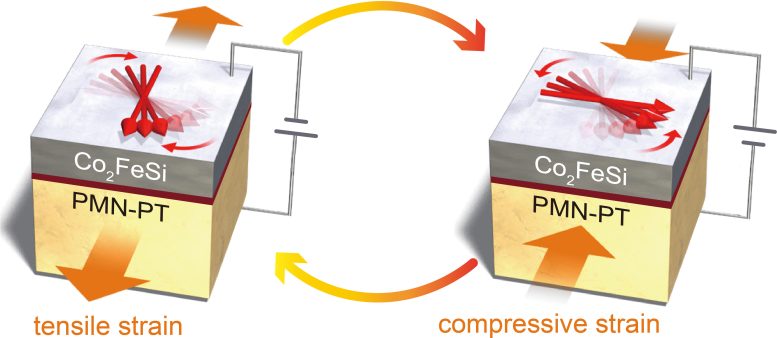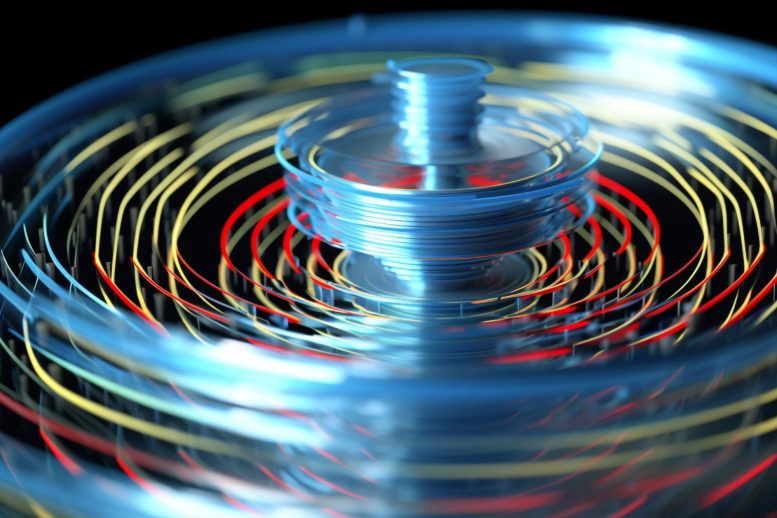Japanese Scientists Pave the Way for Next-Gen Spintronics
Researchers have developed a method to control magnetization direction in spintronic devices using a low electric field through a breakthrough in interfacial multiferroics. This technique, which relies on straining orbital magnetic moments, could significantly improve the efficiency and power consumption of future spintronic technologies.
Scientists demonstrate the ability to control the direction of magnetization by applying strain to a multiferroic material at the interface.
Directing magnetization with a low electric field is crucial for advancing effective spintronic devices. In spintronics, the characteristics of an electron’s spin or magnetic moment are leveraged for information storage. By modifying orbital magnetic moments through strain, it’s possible to manipulate electron spins, leading to an enhanced magnetoelectric effect for superior performance.
Japanese researchers, including Jun Okabayashi from the University of Tokyo, revealed a strain-induced orbital control mechanism in interfacial multiferroics. In multiferroic material, the magnetic property can be controlled using an electric field—potentially leading to efficient spintronic devices. The interfacial multiferroics that Okabayashi and his colleagues studied consist of a junction between a ferromagnetic material and a piezoelectric material. The direction of magnetization in the material could be controlled by applying voltage.

Interfacial multiferroic structure and control of magnetization orientation. Credit: Takamasa Usami
Mechanism and Implications for Spintronic Devices
The team showed the microscopic origin of the large magnetoelectric effect in the material. The strain generated from the piezoelectric material could change the orbital magnetic moment of the ferromagnetic material. They revealed element-specific orbital control in the interfacial multiferroic material using reversible strain and provided guidelines for designing materials with a large magnetoelectric effect. The findings will be useful in developing new information writing technology that consumes less power.
Reference: “Strain-induced specific orbital control in a Heusler alloy-based interfacial multiferroics” by Jun Okabayashi, Takamasa Usami, Amran Mahfudh Yatmeidhy, Yuichi Murakami, Yu Shiratsuchi, Ryoichi Nakatani, Yoshihiro Gohda and Kohei Hamaya, 10 January 2024, NPG Asia Materials.
DOI: 10.1038/s41427-023-00524-6
The study was funded by the Japan Society for the Promotion of Science, the Japan Science and Technology Agency, The Spintronics Research Network of Japan, and the Yazaki Memorial Foundation for Science and Technology.

Researchers have developed a method to control magnetization direction in spintronic devices using a low electric field through a breakthrough in interfacial multiferroics. This technique, which relies on straining orbital magnetic moments, could significantly improve the efficiency and power consumption of future spintronic technologies.
Scientists demonstrate the ability to control the direction of magnetization by applying strain to a multiferroic material at the interface.
Directing magnetization with a low electric field is crucial for advancing effective spintronic devices. In spintronics, the characteristics of an electron’s spin or magnetic moment are leveraged for information storage. By modifying orbital magnetic moments through strain, it’s possible to manipulate electron spins, leading to an enhanced magnetoelectric effect for superior performance.
Japanese researchers, including Jun Okabayashi from the University of Tokyo, revealed a strain-induced orbital control mechanism in interfacial multiferroics. In multiferroic material, the magnetic property can be controlled using an electric field—potentially leading to efficient spintronic devices. The interfacial multiferroics that Okabayashi and his colleagues studied consist of a junction between a ferromagnetic material and a piezoelectric material. The direction of magnetization in the material could be controlled by applying voltage.

Interfacial multiferroic structure and control of magnetization orientation. Credit: Takamasa Usami
Mechanism and Implications for Spintronic Devices
The team showed the microscopic origin of the large magnetoelectric effect in the material. The strain generated from the piezoelectric material could change the orbital magnetic moment of the ferromagnetic material. They revealed element-specific orbital control in the interfacial multiferroic material using reversible strain and provided guidelines for designing materials with a large magnetoelectric effect. The findings will be useful in developing new information writing technology that consumes less power.
Reference: “Strain-induced specific orbital control in a Heusler alloy-based interfacial multiferroics” by Jun Okabayashi, Takamasa Usami, Amran Mahfudh Yatmeidhy, Yuichi Murakami, Yu Shiratsuchi, Ryoichi Nakatani, Yoshihiro Gohda and Kohei Hamaya, 10 January 2024, NPG Asia Materials.
DOI: 10.1038/s41427-023-00524-6
The study was funded by the Japan Society for the Promotion of Science, the Japan Science and Technology Agency, The Spintronics Research Network of Japan, and the Yazaki Memorial Foundation for Science and Technology.
